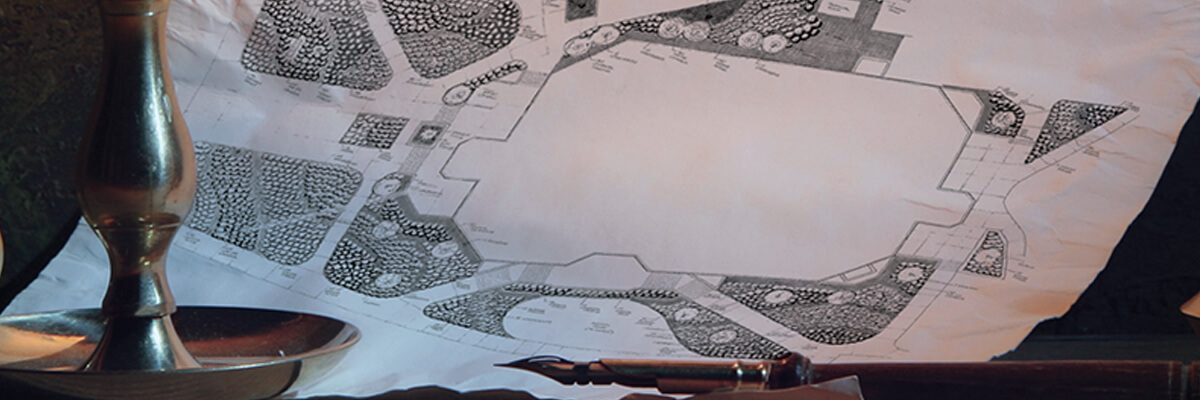The history of landscape architecture starts when humanity abandons nomadic life and becomes settled. People who tied to the land and chose agriculture as a source of livelihood uncover the first examples of gardening. This history dates back to 11,000 years ago, leaving traces in Mesopotamia, Egypt, Iran, Ancient Greece and Ancient Rome.
History of Landscape Architecture in ancient era civilizations
Landscape Architecture in Mesopotamia:
The most magnificent of the gardens in Mesopotamia are found during the Babylonians. Built in the Royal Palace in Babylon, these gardens are roof gardens built on a range of terraces. It consists of gardens, porches and terraces rising over arched walls. The terraces are covered with stone balconies. In order to prevent leakage from the terraces while watering the balconies, the floor is covered with layers of various materials such as reeds and pitch. This monument, known as the Hanging Gardens of Babylon, is now known as one of the Seven Wonders of the World.
Landscape Architecture in Egypt: Gardens in Egypt become important enough to be drawn on papyruses and walls. Especially the temple gardens and the gardens of the rich Egyptians are about 10,000 m long. Palm, figs and acacia are usually placed in these square areas. Large and deep pools of water, from the Nile, were built and designed to allow the ruler and his relatives to roam with boats and bathe.
Renaissance and Landscape Architecture: Renaissance gardens were located at the dominant points of the hill. The building and the garden are designed in harmony both in terms of size and architecture. In the gardens, cypress, peanut pine, bay, boxwood citrus species, green oak species such as architectural forms of green plants were used. These plants were pruned into walls or various animal figures and geometric shapes were created. Color difference has been created in the garden with various shades of green. The garden of the Italian Renaissance, which lived its most brilliant period between 1503 and 1573, later changed its shape into Baroque garden art.
Baroque Era or French Garden Style; the center of art movements in the first half of the 18th century, has brought the perception of space to eternity with the gardens of Versailles. According to the approach/understanding of the gardens which has become formal;
a) The main lines of the garden should be as simple as possible and the details should be detailed. b) There must be integrity/unity in the plan. c) The garden should be kept open and very wide suitable for holidays and other kinds of entertainment. d) The main part of the garden should be open and this open part should be surrounded by closed private gardens. e) Number of fountains, fountains and pools should be kept high.
Landscape Architecture in Iran: In the arid and hot Iranian steppes, the longing for shade, water and green lead to the formation of paradise gardens called paradise. After the Islamic period, the influence of religious beliefs began to be seen in the selection of trees and flowers used in gardens. For example, death and loneliness of cypress trees in the garden; hope, joy and life of blossoming plum, almond and cherry trees; fragrant roses and jasmines are used to express a corner of heaven. The Islamic garden approach in A.D. 9th and 13th centuries entered Spain through Andalusian Umayyads and later was spread throughout Europe.
Landscape Architecture in Far East; The most prominent feature of Chinese imperial palace gardens is the importance given to privacy, despite their hugeness. The gardens are shaped as a piece of nature that has been minimized by its cliffs, hills, lakes and streams. There are bridges on the water facilities. The courtyards are surrounded by high stone or plaster covered walls. The main function of these walls is to raise funds for shadow play of the leaves and branches of plants rather than privacy. The stones, pebbles and mosaic and grass plants were used as flooring. In Japanese gardens, water, bridges, gazebos, stones, stone oil lamps, garden pagodas, plants, siege elements and step stones and paving stones constitute the Japanese garden elements.
Landscape Architecture in Ancient Rome; In Roman architecture, the power of the empire was symbolized by the size of the buildings. Marble tables and small sculptures are used frequently in Roman gardens in stone-water union. The gardens were decorated with rectangular or squared canal pools. Pergolas, vases, bronze and sculptures which were made of marble or iron are placed in a symmetrical layout.
Occupational Developments in Landscaping Architecture
The well-planned and well-designed urban environments and residences become more important in the years to come. Olmsted, Vaux and Horace Cleveland, the first pioneers of slowly developing and professional garden design, were the pioneers in the city planning movement. In 1899, they established the Landscaping Architects of American Society with 11 people, bringing together the first professional community in this field.
Home home, sweet home. My Garden is My Heaven. When we look at today, was founded in 1974 in Turkey, Cem Botanic brings plus understanding of the structure of the garden. Demonstrates impressive ways to symbolize power and peace in homes in its most modern form.








